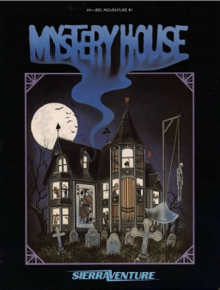Mystery House
| Mystery House | |
|---|---|
 Cover art | |
| Developer(s) | On-Line Systems |
| Publisher(s) | On-Line Systems |
| Designer(s) | Roberta and Ken Williams |
| Series | Hi-Res Adventure |
| Platform(s) | Apple II, iOS |
| Release date(s) | 1980, 1982 |
| Genre(s) | Adventure |
| Mode(s) | Single player |
Mystery House is an adventure game released in 1980 by Roberta and Ken Williams for the Apple II. The game is remembered as one of the first adventure games to feature computer graphics and the first game produced by On-Line Systems, the company which would evolve into Sierra On-Line. Because of its use of graphics, GamePro named Mystery House the 51st most important game of all time in 2007.[1]
Plot

The game starts near an abandoned Victorian mansion. The player is soon locked inside the house with no other option than to explore. The mansion contains many interesting rooms and seven other people: Tom, a plumber; Sam, a mechanic; Sally, a seamstress; Dr. Green, a surgeon; Joe, a gravedigger; Bill, a butcher; and Daisy, a cook.
Initially, the player has to search the house in order to find a hidden cache of jewels. However, terrible events start happening and dead bodies (of the other people) begin appearing. It becomes obvious that there is a murderer on the loose in the house, and the player must discover who it is or become the next victim.
Development
At the end of the 1970s, Ken Williams sought to set up a company for enterprise software for the market-dominating Apple II computer. One day, he took a teletype terminal to his residence to work on the development of an accounting program. Rummaging through a catalogue, he found a program called Colossal Cave Adventure. He and his wife Roberta both played it all the way through and their encounter with this game would have a strong influence on video-gaming history.
Having finished Colossal Cave Adventure, they began to search for something similar, but found the market underdeveloped. Roberta Williams liked the concept of a textual adventure very much, but she thought that the player would have a more satisfying experience with images and began to think of her own game. She thus conceived Mystery House, the first graphical adventure game, a detective story inspired by Agatha Christie's And Then There Were None.
Ken spent a few nights developing the game on his Apple II using 70 simple two-dimensional drawings done by Roberta. The software was packaged in Ziploc bags containing a 5¼-inch disk and a photocopied paper describing the game and was sold in local software shops in Los Angeles County.[citation needed] To their great surprise, Mystery House was an enormous success, quickly becoming a best-seller at a first-release price of US$24.95. Eventually, it sold more than 10,000 copies, which was a record-breaking phenomenon for the time.
Though Ken believed that the gaming market would be less of a growth market than the professional software market, he persevered with games. In 1980, the Williamses founded On-Line Systems, which would become Sierra On-Line in 1982.
Mystery House was re-released in 1982 through the SierraVenture line, which produced a number of early Sierra games until 1983.
Legacy
Though the game is often considered the first to use graphics, role-playing video games had already been using graphics for several years at the time of release. Applying graphics to an adventure game, however, was unprecedented as previous story-based adventure games were entirely text-based.
In Japan, several different adventure games under the title Mystery House were released. In 1982, MicroCabin released Mystery House, which was unrelated to (but inspired by) the On-Line Systems game of the same name. The following year, the Japanese company Starcraft released an enhanced remake of On-Line Systems' Mystery House with more realistic art work and depiction of blood, while Mystery House II for the MSX was released as a sequel to MicroCabin's Mystery House.[2]
Mystery House was satirized in the 1982 adventure game Prisoner 2. One location from the game was a spooky house, whereupon his arrival the player is told, "He's killed Ken!"—that is Ken Williams—and must seek absolution for murder. Elements from the game were later reintroduced in the Sierra On-Line game The Colonel's Bequest in 1989.
References
- ↑ "The 52 Most Important Video Games of All Time". GamePro. 2007-04-24. Archived from the original on 2007-05-20. Retrieved 2007-04-25.
- ↑ Kalata, Kurt (May 10, 2010). "The Mystery of the Japanese Mystery House". Hardcore Gaming 101. Retrieved 19 September 2011.
External links
| Wikimedia Commons has media related to Mystery House. |
| ||||||||||||||||||||||||||||||||||||||||||||||||||||||||||||||||||||||||||||||||||||||||||||||||||||||||||||||